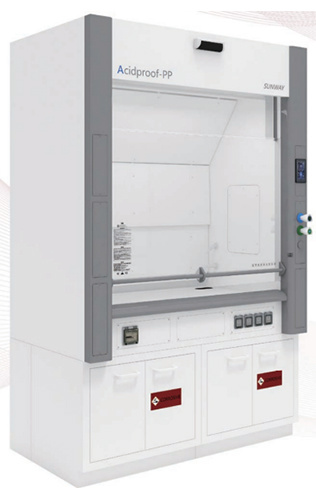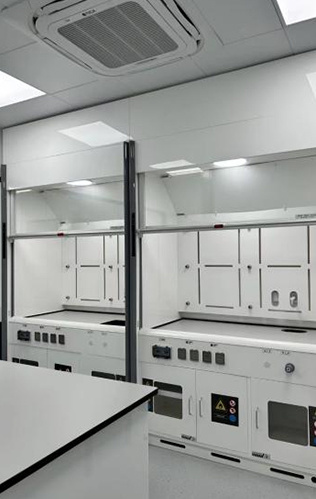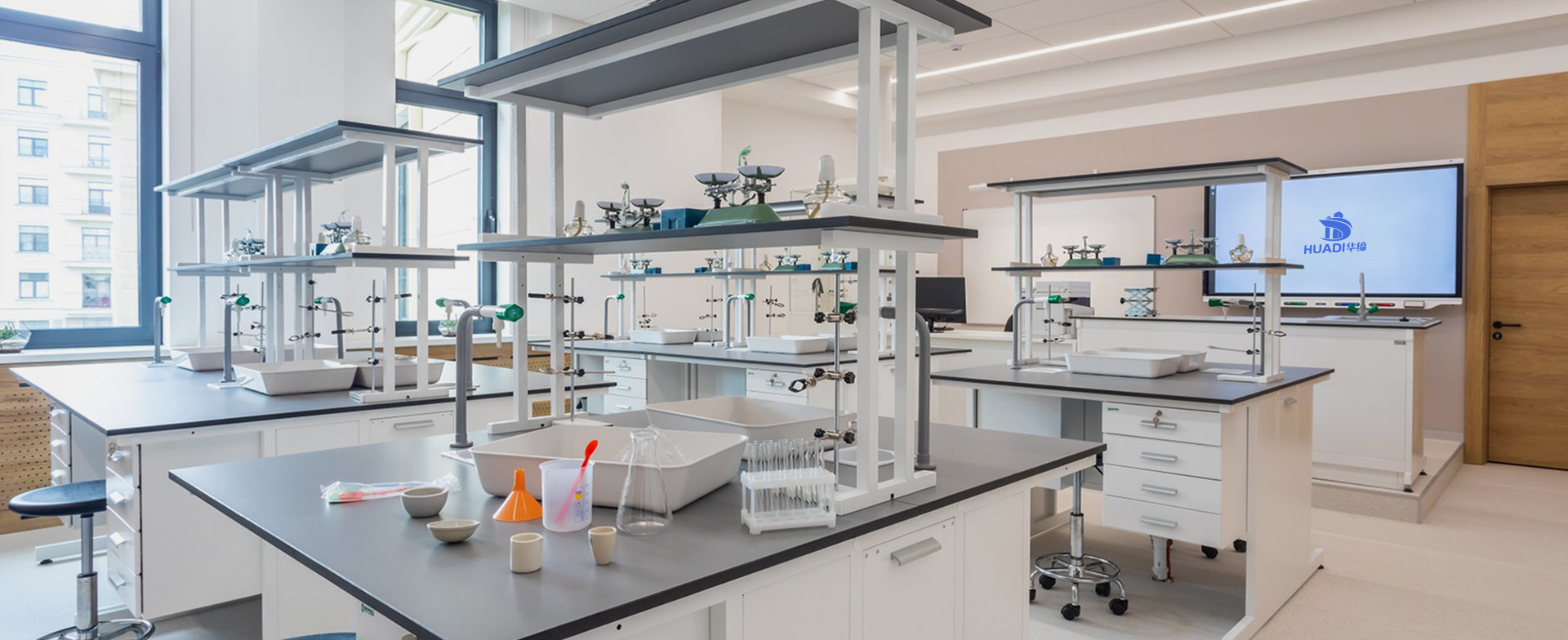Laboratory Furniture Assembly System
1. General treatment requirements for the surface of laboratory-grade steel furniture
1. The surface of all steel laboratory bench cabinets must be treated with electrostatic epoxy resin powder spraying. The coating must be flat and smooth. No spray coating shedding, bubbling, dents, indentations, surface scratches, pits, cracks, corner collapse and cutting edges are allowed;
2. Pretreatment: degreasing, water washing, pickling, water washing and neutralization, phosphating, water washing and other processes or nano-ceramic pre-treatment technology;
3. Surface spraying: electrostatic spraying of epoxy resin powder with excellent environmental protection powder quality, coating thickness ≥50μm, solidified into a smooth surface in a high-temperature oven at 180 degrees.
2. Laboratory tables (side tables, central tables, instrument tables, corner tables, instrument corner tables, etc.)
(1) Structural requirements:
adopt all-steel floor-standing structures, the size of the side table is L*750mm*850mm, the size of the central laboratory table is: L*1500 mm*850mm, the size of the corner table is 1000mm*1000mm*850mm, and the size of the instrument table is L*800/900mm*850mm.
(2) Cabinet requirements:
2.1. Steel: meet the requirements of excellent cold-rolled steel plate.
2.2. Bottom cabinet: adopt 1.0mm cold-rolled steel plate, all surface joints of sheet metal should be fully welded, and the welding points should be polished to maintain a continuous smooth surface. There are upper and lower adjustment holes for the shelves in the cabinet, and each bottom cabinet is equipped with a movable shelf.
2.3. Drawer: adopt 1.0mm cold-rolled steel plate, the drawer panel is a double-layer structure, the internal filling material, the drawer can be pulled out ≥330mm, and the drawer design should be easy to disassemble.
2.4. Door panel: 1.0mm cold-rolled steel plate is used. The door panel is a double-layer structure, filled with sound-absorbing materials, and has anti-collision rubber pads on the inside.
2.5. Movable shelf: 1.0mm cold-rolled steel plate is used. The edge of the shelf should be smooth and not cut your hands. The upper and lower adjustment spacing of each shelf should be ≤20mm.
2.6. Cabinet: The cabinet depth is ≥520mm, and the height (including adjustment feet and table thickness) is 850mm (±2%) unless otherwise specified.
2.7. Back panel: The back of the base cabinet should be equipped with a movable back panel that is easy to disassemble and install.
2.8. Service channel: There is a service channel distance between the middle space of the back-to-back cabinet of the central table and the middle space between the cabinet and the wall of the side table, which is used to lay out electricity, water, and gas pipelines. It is a hidden design.
2.9. All components shall not be welded and processed at the installation site to avoid damaging the epoxy resin coating on the surface.
2.10. There is no central vertical pillar blocking the two doors of all double-door style base cabinets.
2.11. Seat space: connected with horizontal bars. If keyboards are required, they are connected with the upper ends of the cabinet units on both sides with horizontal keyboard drawer connectors. The space below should be covered with detachable cover plates.
2.12. Decorative cover plates: According to the drawings and relevant instructions, the space between the back-to-back cabinets of the central table, between the bottom cabinets, the back of the instrument table cabinet that is not against the wall, and the outside of the space between the cabinet and the wall of the side table should be covered with steel decorative cover plates. The color of the cover plates should be the same as that of the cabinets. Decorative cover plates shall not be directly processed and made of other materials on site. All decorative cover plates are detachable and their assembly screws shall not be exposed.
(3) Hardware accessories requirements:
3.1. Hinge: Made of stainless steel, with an opening angle of ≥135 degrees;
3.2. Slide rail: Meet laboratory requirements;
3.3. Handle: High-strength stainless steel handle, aluminum alloy or other laboratory-suitable handle; two handles should be provided when the drawer width exceeds 600mm or more.
3.4. Foot: The base cabinet has four adjustable galvanized steel, stainless steel screw structure or other laboratory-suitable support feet with rubber coating, which can be adjusted by special tools for level and height, with a maximum adjustment of 30mm.
3.5. Door buckle set: The roller is made of plastic material and the roller bracket is made of galvanized steel; it must be fixed to the cabinet and door panel with steel pointed galvanized self-tapping screws.
3.6. Shelf support buckle: Stainless steel or other laboratory-suitable materials.
3.7. Power socket: 220V, 10A multi-function socket is suitable for various instrument plugs.
(4) The performance meets the requirements of SEFA 8M-2016 laboratory grade metal cabinets and the requirements of EN14727:2005 laboratory storage furniture applicable parts.
(5 ) The table top can be made of: physical and chemical board, epoxy resin board, ceramic table top.
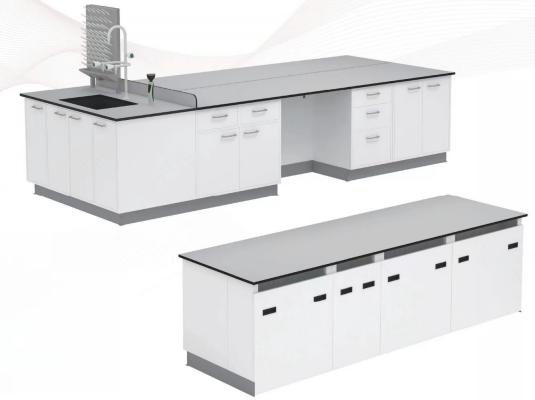
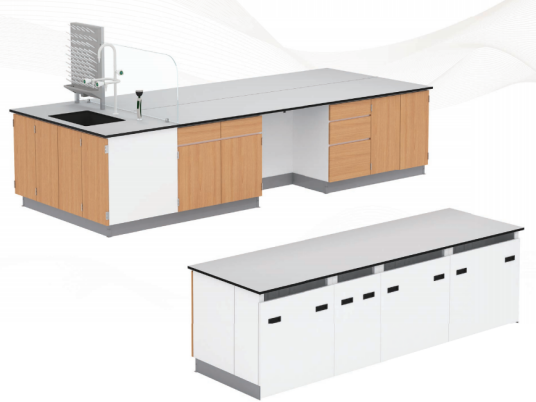
3. Gas cylinder cabinet
(1) Specification: 900*450/500*1800/2000;
(2) Structure: All-steel structure;
(3) Cabinet body:
3.1. The cabinet body is made of 1.0mm thick cold-rolled steel plate by punching, folding and welding. The surface is pickled and phosphated and then sprayed with epoxy resin electrostatic powder. The spraying thickness is ≥75μm. The physical and chemical properties of the steel plate metal spray coating such as hardness, impact strength, corrosion resistance, adhesion, etc. meet the requirements of GB/T 3325-2008 "General Technical Conditions for Metal Furniture".
3.2. The side panels are made of 1.0mm thick cold-rolled steel plate by welding. The surface is sprayed with epoxy resin powder. The hinges, slide rails and shelf hooks can be fixed. There are rows of holes in the front and back to adjust the shelf up and down.
3.3. Cabinet door: The door panel is made of 1.0mm thick cold-rolled steel plate by punching, folding and welding. The surface is pickled and phosphated and then sprayed with epoxy resin electrostatic powder. The structure is stable and does not deform. The inner side of the door panel is equipped with a buffer and shock-absorbing device. The structure is double-layer hollow plus foam.
3.4. Shelf: The shelf is made of 1.0mm thick cold-rolled steel plate by punching, folding and welding. The surface is pickled and phosphated and then sprayed with epoxy resin electrostatic powder. The structure is stable and does not deform. It is equipped with a mold-formed shelf support.
3.5. Handle: One-piece molded handle.
3.6. Hinge: 2.0mm thick 304 stainless steel hinge, anti-corrosion, no noise, good strength, no breakage, and the cabinet door opening angle can reach 180 degrees.
3.7. Height adjustment foot: M10 screw compression molding, bottom lining waterproof black PVC hexagonal ring, to ensure that the steel cabinet can be adjusted horizontally when the cabinet door is open.
3.8. Belt-type gas cylinder fixing device and gas cylinder pallet ramp (2 gas cylinders), with window.
3.9. The alarm gas cylinder cabinet is a full steel structure with 1.0mm thick cold-rolled steel plate and double doors. The cabinet is equipped with anti-falling steel chains to fix the gas cylinders. The bottom is equipped with a gas cylinder transportation ramp. The observation window is 5mm tempered glass, with built-in exhaust fan, split gas detector, and sound and light alarm.
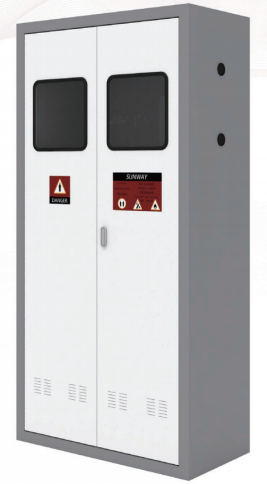
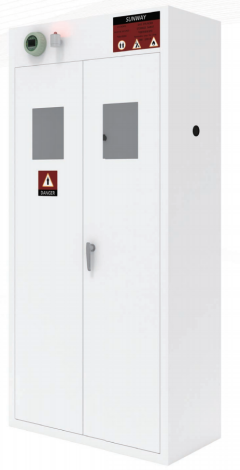
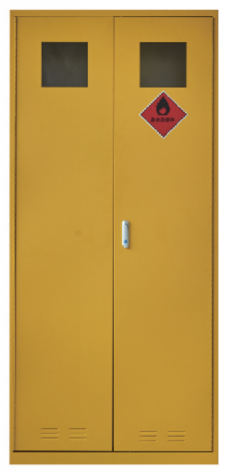
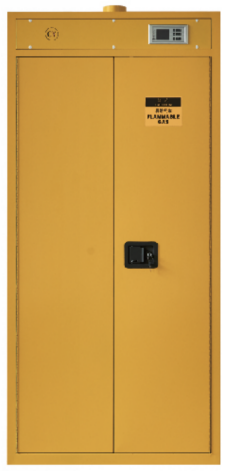
4. Functional cabinets (reagent cabinets/medicine cabinets/sample cabinets, utensil cabinets, lockers, etc.)
(1) Specifications: 900*450/500*1800;
(2) Structure: all-steel structure;
(3) Cabinet body:
3.1. The cabinet body is made of 1.0mm thick cold-rolled steel plate by punching, folding and welding. The surface is pickled and phosphated and then sprayed with epoxy resin electrostatic powder. The spraying thickness is ≥75μm. The physical and chemical properties of the steel plate metal spray coating such as hardness, impact strength, corrosion resistance, adhesion, etc. meet the requirements of GB/T 3325-2008 "General Technical Conditions for Metal Furniture".
3.2. The side panels are made of 1.0mm thick cold-rolled steel plate by welding. The surface is sprayed with epoxy resin powder. The hinges, slide rails and shelf hooks can be fixed. There are rows of holes in the front and back to adjust the shelf up and down.
3.3. Door: The door panel is made of 1.0mm thick cold-rolled steel plate by punching, folding and welding. The surface is pickled and phosphated and then sprayed with epoxy resin electrostatic powder. The structure is stable and does not deform. The inner side of the door panel is equipped with a buffering and shock-absorbing device. The structure is double-layer hollow with foam.
3.4. Shelf: The shelf is made of 1.0mm thick cold-rolled steel plate by punching, folding and welding. The surface is pickled and phosphated and then sprayed with epoxy resin electrostatic powder. The structure is stable and does not deform. It is equipped with a mold-formed shelf support.
3.5. Handle: Zinc alloy handle.
3.6. Hinge: 1.5mm thick 304 stainless steel hinge, anti-corrosion, no noise, good strength, no breakage, the cabinet door opening angle can reach 180 degrees.
3.7. Height adjustment foot: It is molded with M10 screws and lined with waterproof black PVC hexagonal rings to ensure that the steel cabinet can be adjusted horizontally when the cabinet door is open.
4. Cabinet body:
4.1. The cabinet body is made of 1.0mm thick cold-rolled steel plate by punching, folding and welding. The surface is pickled and phosphated and then sprayed with epoxy resin electrostatic powder. The spraying thickness is ≥75μm. The physical and chemical properties of the steel plate metal spray coating such as hardness, impact strength, corrosion resistance, and adhesion meet the requirements of GB/T 3325-2008 "General Technical Conditions for Metal Furniture".
4.2. Cabinet door: The door panel is made of 1.0mm thick cold-rolled steel plate by punching, folding and welding. The surface is pickled and phosphated and then sprayed with epoxy resin electrostatic powder. The structure is stable and does not deform. The inner side of the door panel is equipped with an anti-buffer shock-absorbing device. The structure is double-layer hollow plus foam.
4.3. Shelf: Compact punched movable shelf, each layer can bear 30k, divided into four layers, which can be applied to the specifications of various utensils.
4.4. Drip tray: 5mm PVC material.
4.5. Handle: Zinc alloy C-type handle, easy to open and beautiful appearance.
4.6. Hinge: 1.5mm thick 304 stainless steel hinge, anti-corrosion, no noise, good strength, no breakage, the cabinet door can open at an angle of 180 degrees.
4.7. Foot: High-strength adjustable foot, combined structure, foot material is high-strength nylon, the bottom is designed with anti-slip pattern, and the M10*40 screw connection combination made of galvanized steel has good shockproof performance, and has corrosion resistance, aging resistance, shock absorption and anti-slip functions. The level of the table can be adjusted in an uneven environment, and the height adjustment is 0-30mm.
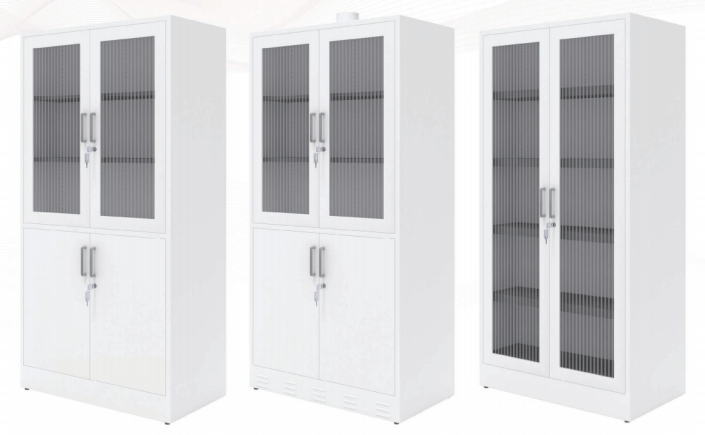
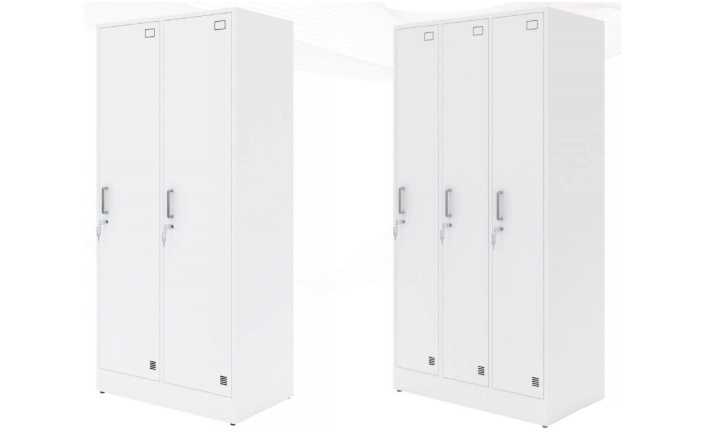
5. Fume Hood Series
(1) European standard fume hood
Overall requirements: It is necessary to meet the relevant requirements of the second and third parts of the fume hood in the EN14175 standard and the relevant requirements of the Ashrae110-2016 standard.
1.1. Specifications and dimensions:
width 1500mm, overall depth 900-960mm, height 2400mm, depth, width, height error ≤1.5mm; adjacent edge verticality: table diagonal, frame diagonal 1000mm above ≤2mm, 1000mm below ≤1.5mm; 1.5m internal operating space width ≥1.41m.
1.2. Modular frame structure:
1) The top contains lighting, automatic doors, and exhaust systems;
2) The middle is a negative pressure operating area, and linings of different materials can be selected to meet different experimental requirements;
3) The lower part is a modular servo panel, which contains independent water, electricity, and gas pipeline systems;
4) The lower cabinet is a movable modular structure.
1.3. Main frame - front:
2.5mm thick one-piece 6063 alloy frame is used. The surface of the alloy frame is treated by pickling, phosphating, high-pressure spraying, and drying. Then, epoxy resin powder is electrostatically sprayed. After being cured at 220°, the coating thickness is ≥75μm, which meets the technical requirements of hardness, corrosion resistance, and adhesion of laboratory furniture. The surface is smooth and uniform, with consistent color, without sagging, wrinkles, bubbles, depressions, or indentations.
1.4. Main frame - rear:
2.5mm thick one-piece 30*50 aluminum alloy bracket is used for support. The M10 screw hot melt extrusion process is used for bearing. The cover is made of fluorocarbon powder sprayed aluminum plate, which is corrosion-resistant, smooth and uniform in surface and consistent in color.
1.5. Lining and guide plate:
5mm thick white laboratory special fume hood anti-Bite board is used, with guide and exhaust design, acid and alkali corrosion resistance, flame retardant, automatic flameout, smooth surface, and density greater than 1.45g/cm³.
1.6. Window:
1) Safety glass [standard tempered glass], high transparency and safety (optional laminated glass, the middle layer of the film is tough and has strong adhesion, it is not easy to be penetrated after being impacted and damaged, the fragments will not fall off, and it is tightly bonded to the film, with shock-resistant and explosion-proof performance).
2) The window frame and guide groove are made of national standard aluminum ingots, stretched and formed by professional molds, and then cut, milled, planed, drilled and tapped by special CNC equipment. The surface is sprayed with epoxy resin powder and cured at 220° high temperature. The coating thickness is ≥75μm, which meets the laboratory's moisture-proof and anti-corrosion requirements. It needs to be matched with a special adjustable guide block to make the sliding door wear-resistant and light, which can effectively solve the traditional stuck phenomenon and can stay at any position in the designated area.
3) The window opening height range is 20mm≤H≤900mm. Safety operation instructions are printed on the window to remind the experimental operator to operate in a standardized manner.
4) The window is equipped with a 500mm automatic mechanical lock. When the sliding door moves up to 500mm, it needs to be manually unlocked before the sliding door can continue to rise. It will be automatically unlocked when it moves down.
1.7. Synchronous belt:
The fume hood lifting adopts imported HMT5 synchronous belt.
1.8. Synchronous pulley:
The synchronous pulley is precision-injected and molded by Saigang. Each synchronous pulley has its own excellent bearing to improve life and precision.
1.9. Lighting:
It adopts a full-cover lamp holder design, built-in three-proof LED lights, and the light intensity is ≥750LUX. It is hidden above the guide plate, easy to maintain, and has explosion-proof function.
1.10. The servo panel adopts an independent structure:
four alloys are used as the skeleton, 5mm aluminum-plastic panels are used, and IP55 circuit breaker protection box [built-in leakage protector, circuit breaker] is built-in, and national standard sockets, water remote control valves, and gas remote control valves can be equipped.
1.11. Sliding door falling function:
1) "Window suspension test" results: When one suspension device is disconnected, the window should stagnate near the initial position.
2) "Splash test" result: The liquid splashed on the inner surface of the window drips from the inner surface of the window and drips on the bottom edge structure of the window, and no liquid overflows.
1.12. The product has low leakage performance:
1) In the "concentration-inner measurement surface test" result, when the window opening is 500mm, the average concentration of SF₆ does not exceed 0.01ppm.
2). In the "concentration-outer measurement surface test" result, when the window opening is 500mm, the average concentration of SF₆ does not exceed 0.01ppm.
3). In the "concentration-interference test" result, when the window opening is 500mm, the average concentration of SF₆ does not exceed 0.01ppm.
1.13. The product has functions:
1). "Window limit and alarm test" result: A limit device is installed to prevent the window from opening beyond the maximum operating position of 450mm marked on the window. When the window opening position returns to below 450mm, the limit device automatically resets. Once the window opening position exceeds 450mm, the sound and light alarm starts to work.
2). "Pressure loss" result: When the fume hood reaches the rated face wind speed of 0.5m/s, its finishing pressure loss should be less than 70pa.
3). "Sliding door pulling force" result: When the fume hood sliding door is lifted and pulled down, the maximum force does not exceed 30N. 1.14, lower cabinet part:
1). The lower cabinet adopts exhaust function, corrosion resistance, acid and alkali resistance.
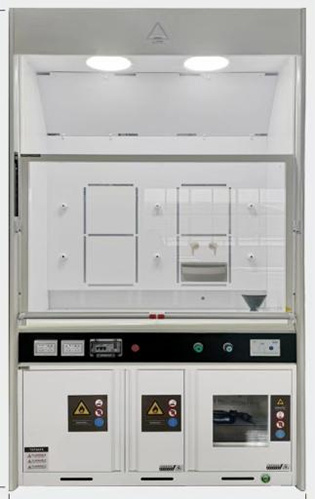
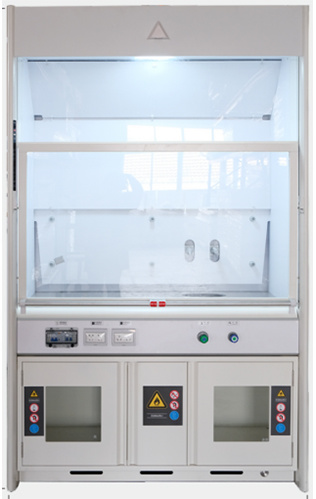
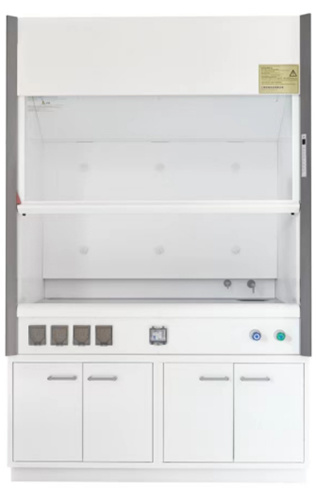
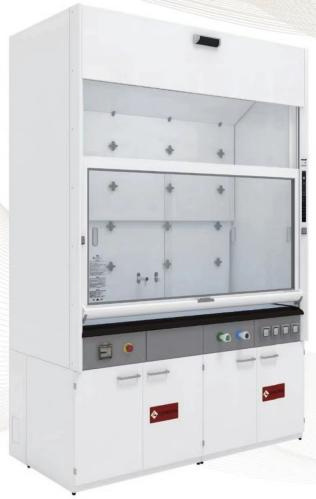
(2) American-style fume hoods
1. Specifications: see the requirements in the list for details;
2. Material: all-steel;
(3) Functions:
3.1. Release function: the harmful gases generated inside the fume hood are diluted by absorbing the gases outside the hood and then discharged to the outside.
3.2. No backflow function: the airflow generated by the exhaust fan inside the fume hood prevents the harmful gases from flowing back into the room from the inside of the fume hood.
3.3. Isolation function: a non-sliding glass window should be used in front of the fume hood to separate the inside and outside of the fume hood. 3.4. Supplementary function
: a channel or alternative device for sucking air from outside the fume hood when exhausting harmful gases.
3.5. Wind speed control function: a certain suction speed is required to prevent the escape of harmful gases in the fume hood. The factors that determine the suction speed of the fume hood air intake are: the heat generated by the experimental content and the relationship with the number of ventilation times. The main factors are the experimental content and the nature of the harmful substances. Generally, the wind speed of non-toxic pollutants is 0.25-0.38m/s, the wind speed of toxic or dangerous harmful substances is 0.4-0.5m/s, and the wind speed of highly toxic or slightly radioactive substances is 0.5-0.6m/s. In order to ensure such wind speed, variable air volume dampers are set up to ensure the required air volume according to different experimental types.
3.6. Heat and acid and alkali corrosion resistance: Some fume hoods need to be equipped with electric furnaces, and some experiments produce a large amount of toxic and harmful gases such as acids and alkalis, which are extremely corrosive. The table, lining, side panels, and selected water nozzles and air nozzles of the fume hood all have anti-corrosion functions.
(4) Structure:
There is a guide plate in the fume hood, which adopts a three-channel vortex exhaust design and is equipped with a reasonable guide structure. The exhaust is smooth without dead corners, and various specific gravity gases can be smoothly discharged from the cabinet. There are circuit control touch switches, power sockets, etc. on the cabinet surface. The perspective window uses 3+3 tempered laminated glass and can be moved up and down for human operation. The countertop can be used to install small water cups and faucets, and the cabinet is located below.
(5) Materials:
5.1. Countertop: 25mm thick solid core laboratory special ceramic countertop is used. The entire countertop is formed by high temperature firing, with a total thickness of 25mm to prevent harmful liquids from spilling (cannot be processed by splicing or later thickening). The countertop is resistant to strong corrosion, high temperature, wear, easy to clean, never deformed or discolored, beautiful, safe, environmentally friendly, and maintenance-free.
5.2. Connectors: Special connectors for mold development, with the surface sprayed with epoxy resin electrostatic powder.
5.3. Cabinet: 1.0MM thick excellent cold-rolled steel plate is used, after pickling, phosphating and other anti-rust treatments, the surface is sprayed with epoxy resin electrostatic powder, the coating thickness is ≥75 microns, and finally cured at high temperature, with strong pressure resistance, acid and alkali resistance, corrosion resistance, and waterproof.
5.4. Cabinet panel: 1.0MM thick high-quality cold-rolled steel plate is used, after pickling, phosphating and other anti-rust treatments, the surface is sprayed with epoxy resin electrostatic powder, the coating thickness is ≥75 microns, and finally cured at high temperature, with strong pressure resistance, acid and alkali resistance, corrosion resistance and waterproof.
5.5. Hinge: 2.0 stainless steel hinge is used.
5.6. Lining: 5mm thick acid and alkali resistant anti-bate plate is used, and the assembly screws are covered with plastic cover plates to avoid contact with the gas in the cabinet and keep beautiful.
5.7. Diversion system: The three-section diversion plate design is made of 5mm anti-bate plate, and the assembly screws are covered with plastic cover plates to avoid contact with the gas in the cabinet and keep beautiful.
5.8. Faucet: Laboratory-specific thickened copper molded single-joint faucet, the valve is a porcelain valve, and the surface is sprayed with epoxy resin to prevent acid and alkali. Corrosion-resistant, heat-resistant, and UV radiation-resistant.
5.9. Water cup: Made of high-density PP material, resistant to strong corrosion, such as aqua regia: The wall thickness can reach 6mm, flat and not deformed. Surface texture: The surface of the groove edge is treated with leather grain, resistant to scratching, consistent with the surface texture of most countertops. Accessories: high-density PP dewatering, filter and water blocking cover, PP dewatering cage. Acid, alkali and impact resistant.
5.10. Electrical: 30W lighting, touch control panel, 10A or 16A three-pole multi-function socket, with dustproof, acid and alkali proof, waterproof design, and equipped with leakage protection switch.
5.11. Window: 3+3mm thick tempered laminated safety glass, high transparency, safety and insurance, window door is designed as car window slide, flexible and convenient to open up and down, low noise, the maximum range of up and down opening is 800mm, the bottom of the sliding door is designed with rubber shock-absorbing pads, which solves the problems of rust, corrosion, fading and aesthetics of the fume hood in the harsh environment of high concentration of acid and alkali and heavy water vapor.
5.12. Explosion-proof devices: explosion-proof sockets, explosion-proof switches, explosion-proof lighting, and explosion-proof glass windows reduce air vortexes inside the fume hood, thereby effectively protecting the health and safety of laboratory personnel.
5.13. Performance requirements: must pass the Ashare110-2016 laboratory fume hood performance test.
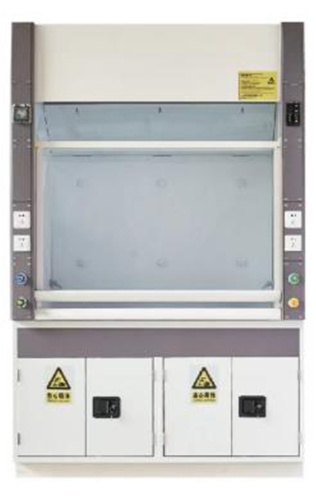
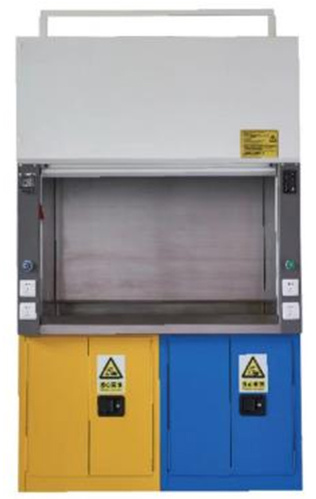
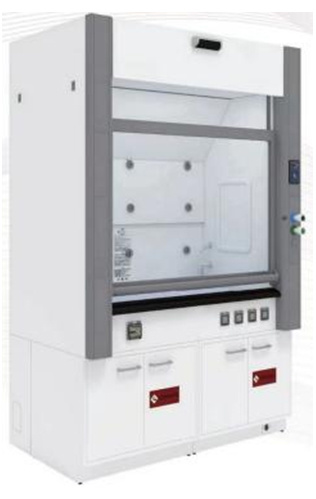
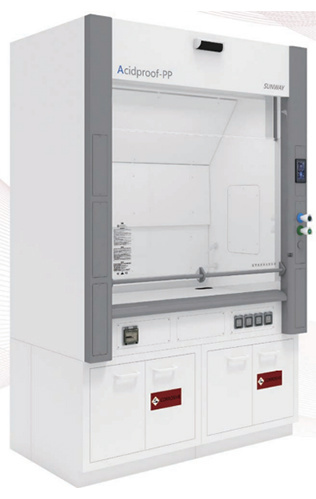
(6) PP fume hood (digestion fume hood)
1. Specification: 1500*850*2350;
2. Material: special PP material;
3. Outer shell: made of PP polypropylene plate by welding, and formed into a whole cabinet after carving and bending once. It has strong acid and alkali resistance and corrosion resistance;
4. Inner shell: It has strong acid and alkali resistance and corrosion resistance. The inner panel can fix the water supply cock, and can be equipped with an air supply cock. The back panel can fix the guide plate, and the top panel is equipped with lighting and gas collecting devices;
5. Guide plate: It has strong acid and alkali resistance and corrosion resistance. It is installed at the back and above the working space. It consists of at least three plates, so that an air chamber is formed between the connection between the working space and the exhaust pipe to discharge the polluted gas evenly. The guide plate is connected to the cabinet body with a guide clip and can be disassembled and assembled repeatedly;
6. Air collecting hood: It is made of PP material and has strong corrosion resistance. The bottom inlet is a rectangular opening and the top outlet is a circular opening;
7. Fluorescent lamp: It uses a 30W three-proof lamp that is waterproof, anti-corrosive and anti-oxidation;
8. Window sliding door: A movable vertical sliding door is placed between the working space and the operator to protect the operator's safety. Combined with the balance position, the sliding door can be stopped at any movable point. There is a tempered glass window above the adjustable door, and the field of vision is completely clear and unobstructed;
9. Window glass: 5mm thick tempered glass is used, which has high strength, good bending resistance, and will not produce small sharp-angled fragments when it breaks;
10. Window suspension cable: Synchronous structure is adopted; the synchronous belt transmission ratio is accurate, the force on the axis is small, the structure is compact, oil-resistant, wear-resistant and anti-aging;
11. Control panel: A liquid crystal control panel is adopted, which is equipped with buttons such as power, switch, lighting, fan and operation indicator light. The LCD display can clearly display the operation status of the fume hood;
12. Socket: Each fume hood is equipped with four 220V single-port universal sockets;
13. Lower cabinet: It is made of brand new PP polypropylene board by welding, and the whole cabinet is formed after carving and bending once. It has strong acid and alkali resistance and corrosion resistance. The door panels are all folded edge structured, solid and firm, not easy to deform, and beautiful overall;
14. Handle: laboratory-specific PP handle, strong corrosion resistance;
15. Hinge: laboratory-specific PP hinge, strong corrosion resistance;
16. Countertop: ceramic countertop.
17. Performance requirements: must be implemented in accordance with Ashare110-2016 laboratory fume hood performance test method and refer to relevant industry standards.
